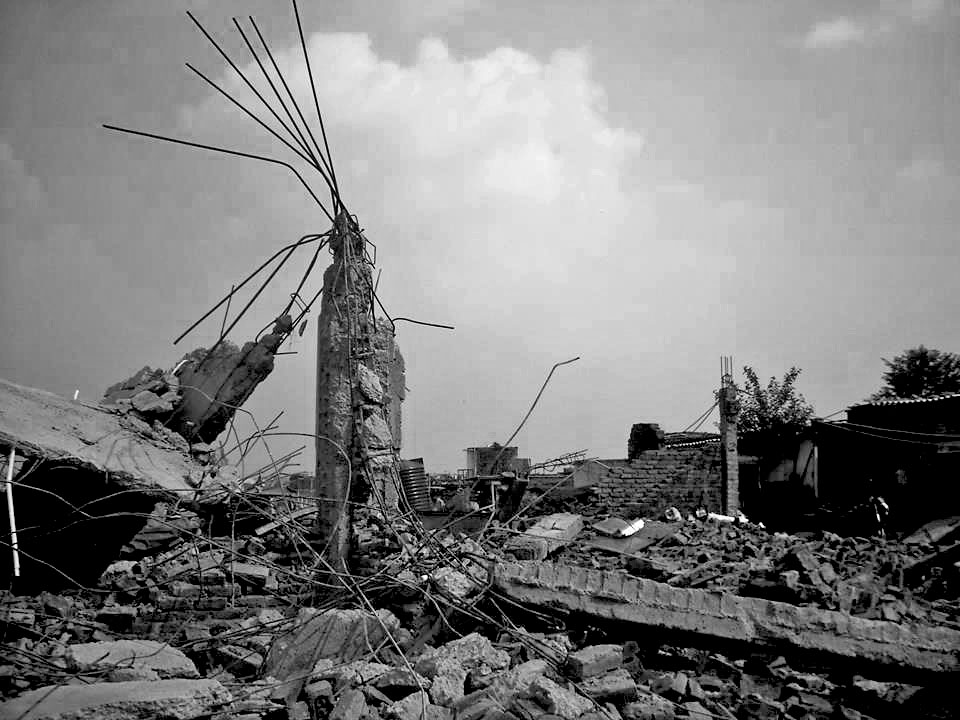by Natasha Narwal
On September 11, 2014, residents of E block, Aya Nagar, Delhi woke up to see bulldozers at their doorstep. Accompanied by the police and Central Reserve Police Force (CRPF), they came without any notice and started demolishing houses, not even giving the residents time to save their belongings.
Sanhati reports that at least two were killed: an elderly woman struck by a wall and pregnant woman who suffered shock. Besides the injuries inflicted on the body, the residents’ minds have been scarred by the site of their houses, their investments of a lifetime being reduced to a pile of rubble in a moment.
After the bulldozers had left, Deewan Singh, a daily wage worker and a resident of the colony sat outside the rubble which was once his house. Seething with rage that contorted his face, he lamented sarcastically that the promised ‘Achhe Din’ have come consisting of a steep rise in prices of basic necessities and now not even a roof on his head. Singh was referencing a popular slogan used by the BJP during the recent Lok Sabha elections.
“The whole Aya Nagar is built on illegal purchase of land, then why only our houses sore their eyes-just because we are poor?” asks Anita Devi. Devi and her husband, migrants from Chapra, Bihar, had invested their life’s savings in their house. That house now gone, she stared blankly into the uncertain future, narrating her story while cooking in the makeshift kitchen she has managed to build from the debris of her demolished house.
Aya Nagar is a village located on the southwestern edge of Delhi, on the road to Gurgaon, a satellite city home to luxury apartments and the offices of multinational corporations. In recent years, Aya Nagar has been completely transformed in character into a bustling urban settlement. This is no exception, though, as it is the story of Delhi neighbourhoods like Chattarpur and Maidangarghi as well. This expansion in Aya Nagar was the result of powerful people from the village grabbing land belonging to the local government and forest land and selling it off to various migrants to the city like Singh and Devi, desperate to get a place of their own in this hostile city.
Initially, incoming residents to Aya Nagar were primarily from marginalized sections of society, largely dispossessed landless labourers and low-income settlers from the states of Uttar Pradesh, Bihar, Rajasthan and elsewhere in India. In the last ten to fifteen years, however, the character of Aya Nagar’s population has drastically changed.
Various builders have purchased land from local real estate dealers and built huge buildings and flats to lure more upwardly mobile sections of the working population of the city. Thus, Aya Nagar has become a curious site of designer flats and sprawling markets standing amidst the very modest houses of the working class households that are being further pushed towards the margins. This is in contrast to most areas in Delhi, where there is a clear separation of middle and upper middle class localities on the one hand and working class localities on the other.
Singh came to Aya Nagar with his family in 2005 and purchased a plot of land from a local resident of the village who claimed that the land was his ancestral property and was in the name of one of his relatives. But, apparently, the land belongs to the Gram Panchayat, the local government. Despite purchasing the land and investing a lifetime in building a house over it, Singh is still an ‘illegal’ resident.
This is true for most of the residents of the area. They live on the hyphen between legality and illegality, in the ‘gray zone’ of informality neither fully integrated nor completely excluded from the city, becoming fully visible to the state only when they become an eyesore.
The establishment and growth of such ‘informal’ settlements like Aya Nagar have been an integral part of the making of urban spaces. To quote Gautam Bhan, “Like most Indian megacities, the planned city of Delhi is only a small part of the city as a whole, and historically it has always been so. The peripheral constructions and the ‘wait and watch’ game of post- facto regularization has, in fact, been the means by which much of the urban space of the city has been organized.”
Neither informal settlements nor evictions and demolitions are new to Delhi. The settlements in Aya Nagar weren’t hidden from either public view or the state. A community of nearly 5000 people with public services and an expansive built environment cannot, by any stretch of the imagination, be covert. As Ananya Roy writes:
Informality is not just that which is outside the planned/formal, as some kind of neatly bound residual order that lies beyond the state and formal planning. The informal, in fact, is “produced by the state itself”. The planning and legal apparatus of the state has the power to determine when to enact this suspension, to determine what is informal and what is not, and to determine which forms of informality will thrive and which will disappear. State power is reproduced through the capacity to construct and reconstruct categories of legitimacy and illegitimacy.

